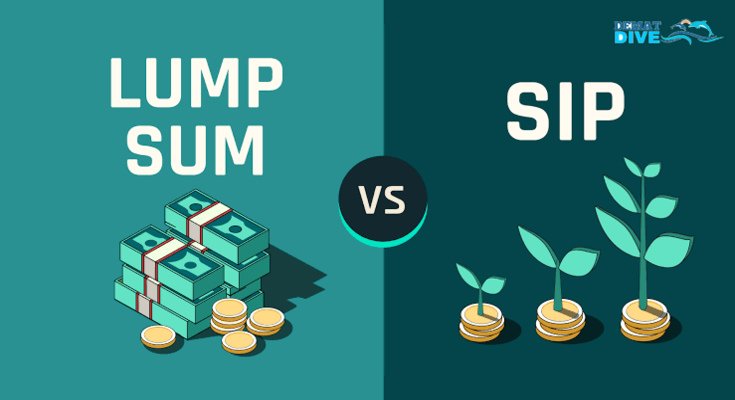SIP vs.Lump Sum: Which Investment Strategy Works Better?

Investing is the cornerstone of building wealth and achieving financial goals. Among the various options available, mutual funds have emerged as a popular choice, offering diverse schemes tailored to meet individual requirements. When it comes to investing in mutual funds, there are two primary methods: Systematic Investment Plans (SIPs) and Lump Sum investments. Both strategies have their merits and drawbacks, making it crucial for investors to understand which works better based on their financial goals, risk appetite, and market conditions.
This article dives deep into the SIP vs. Lump Sum debate, providing high-quality insights, detailed explanations, and practical Indian examples to help you make informed investment decisions.
What is a SIP?
A Systematic Investment Plan (SIP) allows you to invest a fixed amount of money periodically in a mutual fund scheme. This can be weekly, monthly, or quarterly, making it a disciplined approach to investing.
Key Features of SIP
- Rupee Cost Averaging: SIPs help average out the purchase cost of mutual fund units by spreading investments over time, regardless of market conditions.
- Low Entry Barrier: SIPs require minimal initial investment, starting as low as ₹500 per month.
- Compounding Effect: Regular investments combined with compounding over the long term lead to significant wealth creation.
Example: Aman starts a SIP of ₹5,000 per month in an equity mutual fund. Over 20 years, assuming an annual return of 12%, Aman’s total investment of ₹12,00,000 grows to approximately ₹50,00,000.
What is a Lump Sum Investment?
A Lump Sum investment involves investing a large amount of money in one go into a mutual fund scheme. This method works well for investors with surplus funds and confidence in the timing of their investment.
Key Features of Lump Sum Investment
- Market Timing: Returns depend heavily on market conditions at the time of investment.
- Potential for High Returns: Lump sum investments can generate substantial returns during a bullish market phase.
- Immediate Deployment: A single investment ensures that your entire corpus starts working for you immediately.
Example: Ravi invests ₹10,00,000 as a lump sum in an equity mutual fund. Over 10 years, assuming an annual return of 12%, his investment grows to approximately ₹31,00,000.
SIP vs. Lump Sum: A Comparative Analysis
1. Market Volatility
- SIP: Ideal for volatile markets as it averages out the cost of investment.
- Lump Sum: Riskier in volatile markets; the timing of the investment significantly impacts returns.
Indian Example: During the market crash of 2020 caused by the COVID-19 pandemic, investors who used SIPs benefited from lower unit costs during the downturn, while lump sum investors faced significant short-term losses.
2. Investment Discipline
- SIP: Encourages regular savings and systematic investment, making it easier for salaried individuals to invest monthly.
- Lump Sum: Requires financial discipline to allocate a large amount for investment, which might be challenging for those with irregular income.
3. Return Potential
- SIP: Generates consistent returns over the long term due to rupee cost averaging and compounding.
- Lump Sum: Offers higher return potential if invested during a market low and held for a long duration.
Practical Insight: Investors who invested in lumpsum during the market crash in March 2020 witnessed stellar gains during the subsequent recovery.
4. Flexibility
- SIP: Offers the flexibility to start, pause, or stop investments anytime, suiting changing financial circumstances.
- Lump Sum: Less flexible as the entire corpus is deployed at once.
5. Suitability Based on Investor Profile
| Criteria | SIP | Lump Sum |
|---|---|---|
| Risk Appetite | Suitable for risk-averse investors. | Suitable for high-risk takers. |
| Income Type | Regular salaried individuals. | Investors with a one-time surplus. |
| Market Knowledge | Requires minimal market timing skills. | Requires a deep understanding of market trends. |
| Time Horizon | Long-term wealth creation. | Short to long-term goals depending on market conditions. |
Case Study: SIP vs. Lump Sum for Indian Investors
Scenario: Investing ₹12 Lakhs Over 10 Years
- SIP Method:
- ₹10,000 was invested monthly for 10 years in an equity mutual fund with an average annual return of 12%.
- Outcome: Total investment of ₹12,00,000 grows to approximately ₹23,23,391.
- Lump Sum Method:
- ₹12,00,000 invested at the beginning of 10 years in the same equity fund with a 12% annual return.
- Outcome: Investment grows to approximately ₹37,26,777.
Analysis: While lump sum offers higher returns in a rising market, SIPs provide a safer and more disciplined approach, especially in volatile conditions.
Benefits of SIPs
- Reduced Emotional Bias: SIPs automate investments, reducing emotional decisions driven by market highs and lows.
- Affordable: Suitable for those without large initial capital.
- Compounding Power: Small, regular investments grow exponentially over time.
Benefits of Lump Sum Investments
- Leverages Market Opportunities: Investing during market lows maximizes returns.
- Quick Deployment: Ensures idle funds are immediately put to work.
- Higher Potential Returns: Ideal for experienced investors who can time the market.
When to Choose SIP
- If you have a regular income but lack a large corpus.
- For first-time investors or those new to market dynamics.
- In volatile or unpredictable market conditions.
When to Choose Lump Sum
- If you have surplus funds and can invest during a market correction.
- For experienced investors with knowledge of market cycles.
- When investing in low-volatility instruments like debt funds or fixed-maturity plans.
Combining SIP and lump-sum strategies
Many seasoned investors use a hybrid approach, combining SIPs and lump sum investments to maximize returns and minimize risks.
Example:
- Use a lump sum to invest in debt funds for stability.
- Simultaneously, start SIPs in equity funds for long-term growth.
Key Takeaways for Indian Investors
- Risk Management: Use SIPs to spread investments over time and reduce risk.
- Market Timing: Consider lump sum investments during market corrections or when valuations are attractive.
- Financial Goals: Align your investment method with your financial objectives and time horizon.
- Monitor Regularly: Whether you choose SIP, lump sum, or both, ensure regular monitoring and rebalancing of your portfolio.
Conclusion
The debate between SIP vs. Lump Sum boils down to individual preferences, financial goals, and market conditions. SIPs are ideal for disciplined, long-term investors who prefer a systematic approach, while lump sum investments are suitable for those with surplus funds and market knowledge.
Ultimately, the best strategy is one that aligns with your financial situation and helps you achieve your investment goals. Whether you’re a cautious investor starting with SIPs or a seasoned investor exploring lump sum opportunities, make informed decisions to grow your wealth effectively.
For expert financial insights, visit Rich Path. and start your investment journey today! 🚀
Read more –
Top 5 Mutual Funds for Long-Term Growth in India in 2025
Best Mutual Funds: How to Choose – A Complete Guide
Best Flexi Cap Mutual Funds to Invest in 2025
Disclaimer:
The information provided in this article is for educational and informational purposes only and should not be considered as financial or investment advice. Mutual fund investments are subject to market risks, and past performance is not indicative of future results. Readers are advised to consult with a certified financial advisor or conduct their own research before making any investment decisions. The examples provided are for illustrative purposes and may not reflect actual returns or outcomes. Tax laws and regulations are subject to change and may vary based on individual circumstances. The author and publisher are not responsible for any financial losses or legal implications arising from the use of this information.








